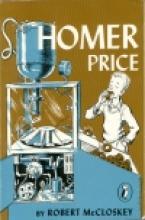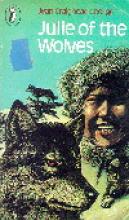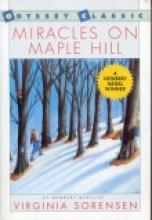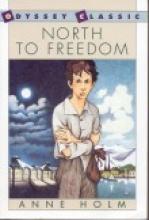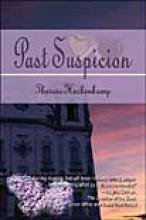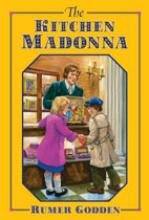Miscellaneous Fiction
Confusion by Cupid
Number of pages:
192 pages
Copyright:
1945
Publisher:
Image Cascade
Binding:
Softcover
Subject(s):
Grade / Age level:
Review:
Continuing in the Jordon family series, this story (Book Three) is based on Peter's, Gwen's, and Alice's love lives. Though each have their own steady dates, (who all happen to be away), they go out with other people and everything ends up in one big mess! Peter goes out with the wrong girl and Gwen gets married, but not to the man she was initially engaged to marry. Alice, like a movie director, keeps everything flowing and everyone informed while her own love life is churning.
Since this is the third book in this series I suggest that it be read after the first two to provide maximum effect.
Since this is the third book in this series I suggest that it be read after the first two to provide maximum effect.
Additional notes:
Reviewer 8th grade homeschooler
Reviewed by:
First reviewed:
1998-99
Homer Price
Subject(s):
Grade / Age level:
Review:
These clever and humorous stories of the adventures of a brainy, problem-solving small-town boy make great reading for grade-schoolers (especially boys) or a terrific read-aloud. This is suitable for rolling-on-the-floor type laughing (not terribly well-suited to bedtime!). A real classic! The sequel, Centerberg Tales is just as good. Older children may also appreciate allusions to liberal naming of townspeople after characters from the Iliad.
Reviewed by:
First reviewed:
3-25-02
Julie of the Wolves
Subject(s):
Grade / Age level:
Review:
Her Eskimo name is Miyax, her American name is Julie. She is journeying through the desolate North Slope of Alaska, from Barrow to Point Hope, and starving. There are no lemmings, which means there are no weasels, no white foxes, no snowy owls - in fact, no food that Miyax can catch with only a knife. Her only hope for survival, she feels, is to befriend the wolves, to become a member of their pack, and this she sets out to do.
The book is divided into three parts - the first part, Amaroq the Wolf, tells in intense anthropological detail how 13 year old Miyax strives to study and become accepted by the wolf pack so she can have a share of their kills. The tone is completely unsentimental but infused with the fervent admiration and affection Miyax feels for these fellow travelers.
The second part is a flashback recounting how Miyax was raised by her father in an Eskimo seal camp until the age of nine, when she had to live with her aunt in order to go to school. In order to escape from this life, she was willing to cooperate in the traditional child-marriage her father had arranged between her and a son of a friend in Barrow. Violence on the part of the young husband drives her into the wild; her goal is to reach a port town and sail to meet her pen pal Amy, who lives in San Francisco.
The third part tells of how her dreams of American civilization, symbolized by her friend Amy's pink room, are shattered by a new act of violence; this time against the wolf she has come to think of as a father. Is American civilization really so civilized after all? The final decision she has to make does not fall along simple black-and-white lines, just as the real-life balance between traditional and modern civilization is not an easy one for today's Eskimos to come to terms with.
This book is a difficult one to review in some ways. Miyax's character is beautifully drawn, and the wolves and the stunning Alaskan environment qualify as characters in their own right in this book. Miyax is so distinctively Eskimo, composing songs to the wolves and skinning caribou with her ulu, and yet so universally a young girl. I can picture some children loving this book and others being put off just because it is so unique.
The book is divided into three parts - the first part, Amaroq the Wolf, tells in intense anthropological detail how 13 year old Miyax strives to study and become accepted by the wolf pack so she can have a share of their kills. The tone is completely unsentimental but infused with the fervent admiration and affection Miyax feels for these fellow travelers.
The second part is a flashback recounting how Miyax was raised by her father in an Eskimo seal camp until the age of nine, when she had to live with her aunt in order to go to school. In order to escape from this life, she was willing to cooperate in the traditional child-marriage her father had arranged between her and a son of a friend in Barrow. Violence on the part of the young husband drives her into the wild; her goal is to reach a port town and sail to meet her pen pal Amy, who lives in San Francisco.
The third part tells of how her dreams of American civilization, symbolized by her friend Amy's pink room, are shattered by a new act of violence; this time against the wolf she has come to think of as a father. Is American civilization really so civilized after all? The final decision she has to make does not fall along simple black-and-white lines, just as the real-life balance between traditional and modern civilization is not an easy one for today's Eskimos to come to terms with.
This book is a difficult one to review in some ways. Miyax's character is beautifully drawn, and the wolves and the stunning Alaskan environment qualify as characters in their own right in this book. Miyax is so distinctively Eskimo, composing songs to the wolves and skinning caribou with her ulu, and yet so universally a young girl. I can picture some children loving this book and others being put off just because it is so unique.
There is nothing wrong with the morality presented in the story that I could find. Miyax strives to maintain her integrity throughout the book in the face of many difficulties. Yet the scene when her young, mentally disabled husband tries to force himself on her might be too much for young readers. It has a pivotal part in the story; it is not dwelt on inappropriately. I think I would give this to an older reader, perhaps a high schooler; with a younger child, you might want to pre-read the troubling section and perhaps discuss it beforehand.
Additional notes:
This book has been recommended by some for our red flag list because of the troubling section mentioned in the review.
Reviewed by:
First reviewed:
3-25-02
Just David
Number of pages:
240 pages
Copyright:
1916
Publisher:
Whole Heart Ministries
Binding:
Sewn Hardcover
Subject(s):
Grade / Age level:
Review:
Young David has grown up in an isolated cabin with his father (since his mother's death when he was only four) in a beautiful mountain setting. There, his father has given him an excellent but unusual education - he is fluent in several languages, knows a great deal about science and nature and plays the violin beautifully. His father has sheltered him from all evil and taught him only what is good and beautiful.
One day he and his father pack their belongings and head back toward civilization. The father, deathly ill, dies on the journey and David finds himself in the care of a well-meaning elderly farm couple. They and most of their neighbors have a very difficult time understanding the golden-hearted David, who makes friends with the lonely and forgotten of the town and soothes many hardened hearts with his beautiful music. David becomes wrapped up in a fairy tale and a mystery which figure heavily in the plot.
Parents may see this story as an embodiment of some of the most fundamental ideas of the homeschool movement. Some will no doubt find it a little sappy. It might make an interesting contrast to the book North to Freedom by Anne Holm, whose character, also called David and of approximately the same age, makes a transition from the evils of a prison camp into a much more beautiful world.
One day he and his father pack their belongings and head back toward civilization. The father, deathly ill, dies on the journey and David finds himself in the care of a well-meaning elderly farm couple. They and most of their neighbors have a very difficult time understanding the golden-hearted David, who makes friends with the lonely and forgotten of the town and soothes many hardened hearts with his beautiful music. David becomes wrapped up in a fairy tale and a mystery which figure heavily in the plot.
Parents may see this story as an embodiment of some of the most fundamental ideas of the homeschool movement. Some will no doubt find it a little sappy. It might make an interesting contrast to the book North to Freedom by Anne Holm, whose character, also called David and of approximately the same age, makes a transition from the evils of a prison camp into a much more beautiful world.
Reviewed by:
First reviewed:
3-25-02
Just Jennifer
Number of pages:
187 pages
Copyright:
1945
Publisher:
Image Cascade
Binding:
Softcover
Subject(s):
Grade / Age level:
Review:
Welcome to the Jordon household of "Army Brats!" Jennifer is a spunky young girl of 16 years left in charge of eight military drilled younger brothers and sisters, while their father, General Jordon, is overseas on duty.
Jennifer and Peter 's mother died when Jennifer was only five. Their father remarried a delightful and kind new mother, who loved them very much. With her came Gwen and Alice, who Jennifer said could only be "half army" (since they weren't born on an Army Post). Then came the twins, Neal and Susan, and Bitsy, who were all declared "definitely army" by Jennifer. Sadly, this mother also died leaving Jennifer in charge.
Right before Gen. Jordon had to leave on overseas duty, a telegram arrived notifying them that Gen. Jordon's brother and wife had died and their son, Donny, had to go live with the Jordons! So, Donny slipped in quietly between Alice and the twins, and since he was a quiet boy, it seemed as if he had been there forever.
Read, also, in this great book how the Jordons moved (under the guidance of a 16 yr. old!) to a nearby lake, adopted a dog, got a horse, encouraged a romance, and befriended a lonely English boy. This was a very good book that I enjoyed immensely.
Jennifer and Peter 's mother died when Jennifer was only five. Their father remarried a delightful and kind new mother, who loved them very much. With her came Gwen and Alice, who Jennifer said could only be "half army" (since they weren't born on an Army Post). Then came the twins, Neal and Susan, and Bitsy, who were all declared "definitely army" by Jennifer. Sadly, this mother also died leaving Jennifer in charge.
Right before Gen. Jordon had to leave on overseas duty, a telegram arrived notifying them that Gen. Jordon's brother and wife had died and their son, Donny, had to go live with the Jordons! So, Donny slipped in quietly between Alice and the twins, and since he was a quiet boy, it seemed as if he had been there forever.
Read, also, in this great book how the Jordons moved (under the guidance of a 16 yr. old!) to a nearby lake, adopted a dog, got a horse, encouraged a romance, and befriended a lonely English boy. This was a very good book that I enjoyed immensely.
Additional notes:
Reviewer 8th grade homeschooler
Reviewed by:
First reviewed:
1998-99
Miracles on Maple Hill
Subject(s):
Grade / Age level:
Review:
Marly and Joe (ages 10 and 12) are two siblings who have always lived in the city. They and their mother had endured the apparent loss of their father during wartime (unclear which war - perhaps Korean) only to discover that he had been a prisoner of war. The family is finally reunited, but their father has changed; he is bitter, touchy, angry, always tired.
Their mother had always spoken of Maple Hill and her grandmother's house that she and her brother had visited each summer as children. Her grandmother had been dead for 20 years, but Marly and Joe loved to hear stories of simple life in the country.
Their mother has a plan. Her grandmother's house has been unoccupied for years, but if they went there for a long visit, perhaps that would help her husband's troubles. And so, they pack their bags and head to rural Pennsylvania just in time for the sugar season...
This is a delightful story that embodies the human need for spending time with God's creation and the virtues of simple living. The writing is interesting and engaging, but not too hurried, with many details about how things are done on a farm (especially the sugar season), plant and animal life, etc.
Their mother had always spoken of Maple Hill and her grandmother's house that she and her brother had visited each summer as children. Her grandmother had been dead for 20 years, but Marly and Joe loved to hear stories of simple life in the country.
Their mother has a plan. Her grandmother's house has been unoccupied for years, but if they went there for a long visit, perhaps that would help her husband's troubles. And so, they pack their bags and head to rural Pennsylvania just in time for the sugar season...
This is a delightful story that embodies the human need for spending time with God's creation and the virtues of simple living. The writing is interesting and engaging, but not too hurried, with many details about how things are done on a farm (especially the sugar season), plant and animal life, etc.
Reviewed by:
First reviewed:
3-25-02
North to Freedom
Subject(s):
Grade / Age level:
Review:
Also known as I Am David (now a major motion picture as well)
Translated from the Danish by L.W. Kingsland
This unusual, but engaging narrative tracks the journey of a young boy as he escapes from a Communist prison camp in Easter Europe, travels by boat to Italy, and gradually makes his way north to Denmark. The story shows the development of the boy's understanding as he begins to grasp the idea of freedom and what makes life worth living. The writing is very good and very thoughtful. The story explores the differences in culture and character of the various countries he visits and invites fruitful discussion about the themes of freedom and good and evil. Readers will find it interesting to follow David's journeys on a map and do further research about Communism. There is one odd statement about the Blessed Mother that might seem somewhat offensive (it is one of the misconceptions non-Catholics sometimes have about Catholic belief) but is certainly not dangerous - it may even be helpful in providing a tangential discussion on misunderstandings about the Church. In following the geography of the story, it will be helpful to know that the city of Salonika is also known as Thessalonika.
Translated from the Danish by L.W. Kingsland
This unusual, but engaging narrative tracks the journey of a young boy as he escapes from a Communist prison camp in Easter Europe, travels by boat to Italy, and gradually makes his way north to Denmark. The story shows the development of the boy's understanding as he begins to grasp the idea of freedom and what makes life worth living. The writing is very good and very thoughtful. The story explores the differences in culture and character of the various countries he visits and invites fruitful discussion about the themes of freedom and good and evil. Readers will find it interesting to follow David's journeys on a map and do further research about Communism. There is one odd statement about the Blessed Mother that might seem somewhat offensive (it is one of the misconceptions non-Catholics sometimes have about Catholic belief) but is certainly not dangerous - it may even be helpful in providing a tangential discussion on misunderstandings about the Church. In following the geography of the story, it will be helpful to know that the city of Salonika is also known as Thessalonika.
Reviewed by:
First reviewed:
3-25-02
Past Suspicion
Subject(s):
Grade / Age level:
Review:
ISBN # 1-59286-802-9
After the death of her mother, a young woman, Robin, must travel from her home in California to a small town in Wisconsin to live with an uncle she never knew existed. She is angry and determined to escape as soon as she turns eighteen, which will be very soon. Almost immediately upon her arrival mysterious things begin to happen. She moves into the room her mother lived in as a young woman and learns a lot about her mother by going through her things. Evidently her mother kept many other secrets, besides having a brother, from her.
Two men enter her life and she is attracted to one and repulsed by the other, yet they both seem to have an interest in her that goes beyond dating. As the story unfolds, Robin finds out that in the past her mother was involved in a life-threatening accident involving a story she was researching for the school paper. She had found a map to a treasure that was part of the history of the town. This incident is what caused her to leave town before Robin was born and to never tell Robin about her family there. The two men know the story of her mother and the treasure, and, the reader finds out, each other very well.
Robin begins to research her mother's accident and the story she was working on. However, the more she discovers about the past, the more danger she herself is in. Still, she can't seem to let it go until she learns the truth.
To tell anymore would give the mystery away. The story follows the formula of the old Victoria Holt romance mysteries where the heroine is attracted to the guy who seems good but turns out to be the bad guy. The true love is one she mistrusts or doesn't understand. The author even uses the Victoria Holt novels as props in part of the plot. It seemed obvious to me as I read it, perhaps because I read all those Victoria Holt novels when I was younger, so I asked a high school girl in my parish to read Past Suspicion and here are her exact words, "It was great! It was kind of slow at the beginning, but it was well worth it!" Although I thought the formula was obvious, there were a few twists that I did not figure out, and that's what you really want in a mystery story.
This is definitely a romance and not heavy reading, but completely morally acceptable. Even though the young woman seems rebellious, she seeks counsel from a priest and works to improve her relationship with her uncle. The romance part of the story is pretty much kept on an intellectual level.
Most impressively, Miss Heckencamp, wrote the draft of this story when she was eighteen. She captures the torn emotions of the main character and the rising sense of danger very adeptly. A high school girl who likes romances would enjoy this story very much.
After the death of her mother, a young woman, Robin, must travel from her home in California to a small town in Wisconsin to live with an uncle she never knew existed. She is angry and determined to escape as soon as she turns eighteen, which will be very soon. Almost immediately upon her arrival mysterious things begin to happen. She moves into the room her mother lived in as a young woman and learns a lot about her mother by going through her things. Evidently her mother kept many other secrets, besides having a brother, from her.
Two men enter her life and she is attracted to one and repulsed by the other, yet they both seem to have an interest in her that goes beyond dating. As the story unfolds, Robin finds out that in the past her mother was involved in a life-threatening accident involving a story she was researching for the school paper. She had found a map to a treasure that was part of the history of the town. This incident is what caused her to leave town before Robin was born and to never tell Robin about her family there. The two men know the story of her mother and the treasure, and, the reader finds out, each other very well.
Robin begins to research her mother's accident and the story she was working on. However, the more she discovers about the past, the more danger she herself is in. Still, she can't seem to let it go until she learns the truth.
To tell anymore would give the mystery away. The story follows the formula of the old Victoria Holt romance mysteries where the heroine is attracted to the guy who seems good but turns out to be the bad guy. The true love is one she mistrusts or doesn't understand. The author even uses the Victoria Holt novels as props in part of the plot. It seemed obvious to me as I read it, perhaps because I read all those Victoria Holt novels when I was younger, so I asked a high school girl in my parish to read Past Suspicion and here are her exact words, "It was great! It was kind of slow at the beginning, but it was well worth it!" Although I thought the formula was obvious, there were a few twists that I did not figure out, and that's what you really want in a mystery story.
This is definitely a romance and not heavy reading, but completely morally acceptable. Even though the young woman seems rebellious, she seeks counsel from a priest and works to improve her relationship with her uncle. The romance part of the story is pretty much kept on an intellectual level.
Most impressively, Miss Heckencamp, wrote the draft of this story when she was eighteen. She captures the torn emotions of the main character and the rising sense of danger very adeptly. A high school girl who likes romances would enjoy this story very much.
Reviewed by:
First reviewed:
7-13-04
The Kitchen Madonna
Subject(s):
Grade / Age level:
Review:
This is a simple, lovely work, of fine literary quality, about a thoroughly modern brother and sister and their blunt Ukrainian maid, who feels out-of-place in London and misses having a "good place" in the kitchen. A good place, according to Marta is something like this: "In my home, Ukrainian home, we make a good place...A place on top of cupboard, perhaps, or perhaps on shelf. Little place but it holy because we keep there Our Lady and Holy Child." When questioned by the children, she explained further. It wasn't a statue and not a picture. "Like picture but more beautiful. They in our churches too. Pictures, but prickled with gold."
The children wrap themselves up in the quest of finding a kitchen Madonna for their Marta. I shouldn't really tell you much more. It's a short story, though not really a kids story; a story for everyone. Very sadly, it is out of print; but it's well-worth your own quest. :)
UPDATE: This has just been reprinted in a lovely, newly-illustrated hardcover edition by Bethlehem Books. Highly recommended!
The children wrap themselves up in the quest of finding a kitchen Madonna for their Marta. I shouldn't really tell you much more. It's a short story, though not really a kids story; a story for everyone. Very sadly, it is out of print; but it's well-worth your own quest. :)
UPDATE: This has just been reprinted in a lovely, newly-illustrated hardcover edition by Bethlehem Books. Highly recommended!
Perspective:
Catholic
Reviewed by:
First reviewed:
10-23-06/ 2-16-10

